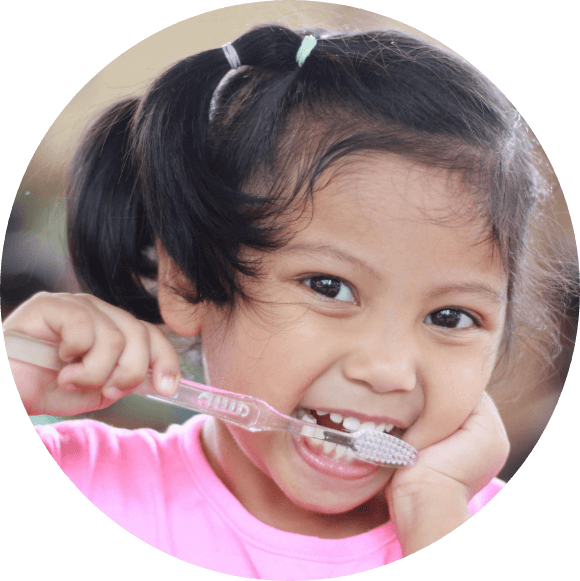
Your child is at the glorious stage of independent oral care—congrats! That’s a big accomplishment (for child and parent!). Children need to keep up the brushing 2x daily and add flossing to their routine. Read on for more helpful tips.
Ever wonder what helps in the prevention of cavities? It’s fluoride! Most commonly found in toothpaste, fluoride is also found in drinking water. Most municipalities add it to their water supply as a matter of public health. Even with this extra boost, you need to make sure your child is getting the right amount.
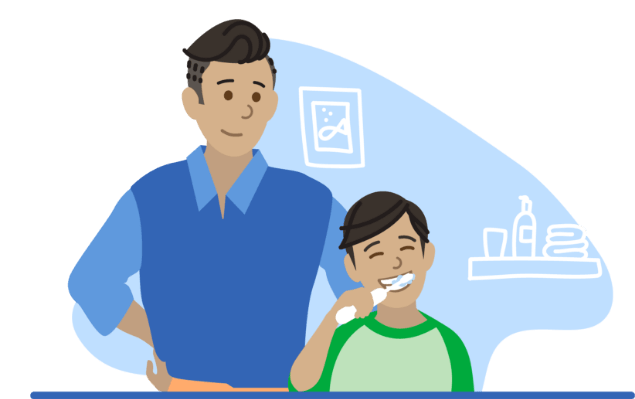
Let’s explore brushing with fluoride toothpaste and how that helps ensure your child’s smile is strong and healthy. Here are 6 steps to ensure brushing becomes second nature to your child.
Get a proper view by standing behind your child as they stand on a stool in front of the mirror. Your little one will feel secure, and you can see their teeth in the mirror.
For the youngster who insists “I can do it by myself,” start small. Invite them to hold the toothbrush as you guide the brush along their teeth. Then, graduate to supervised brushing in the mornings, while you brush teeth at night to ensure thorough cleaning.
A pea-size amount of fluoride toothpaste is all they need. We like the rhyme “not a lot; just a dot” to avoid waste and mess.
Teach your child to angle bristles along gums. Then help them work their way around their teeth and gums in a gentle circular motion. Don’t forget about brushing the tongue to get rid of bacteria!
The American Dental Association recommends brushing for 2 minutes—a lifetime to a little one. Pass the time by brushing and dancing to a favorite song or simply set a timer.
Since you’ve now introduced fluoride toothpaste, your child needs to spit it out after brushing. Rinsing isn’t necessary. The left-behind fluoride toothpaste helps protect teeth.
Around age 5 or 6, your child begins losing baby teeth and adult teeth appear! Between the ages of 6-12, your child will have a mix of both baby and adult teeth.
The bottom front adult teeth are usually the first to appear. Expect the last baby tooth to fall out around age 12. And by age 13, your child should be rocking a full set of 28 adult teeth (the 4 wisdom teeth come a bit later).
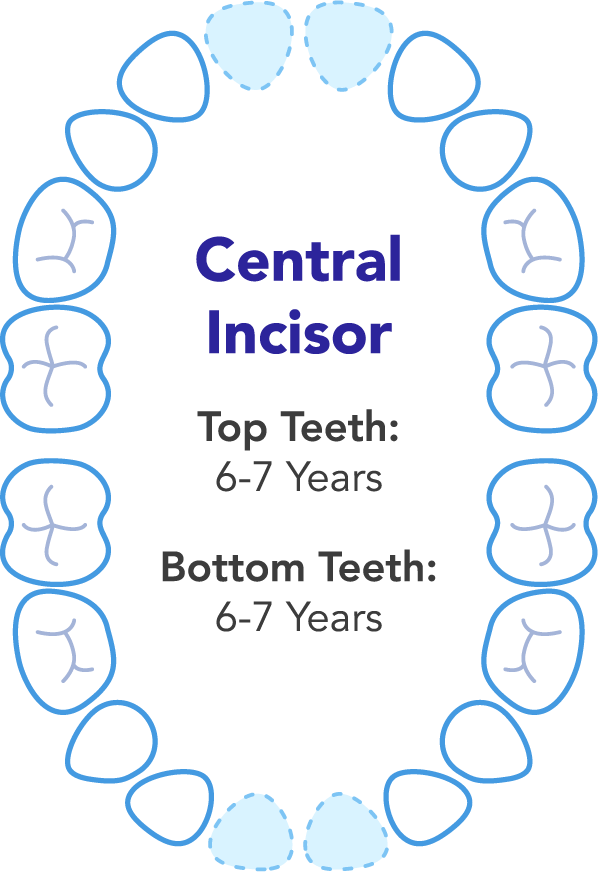

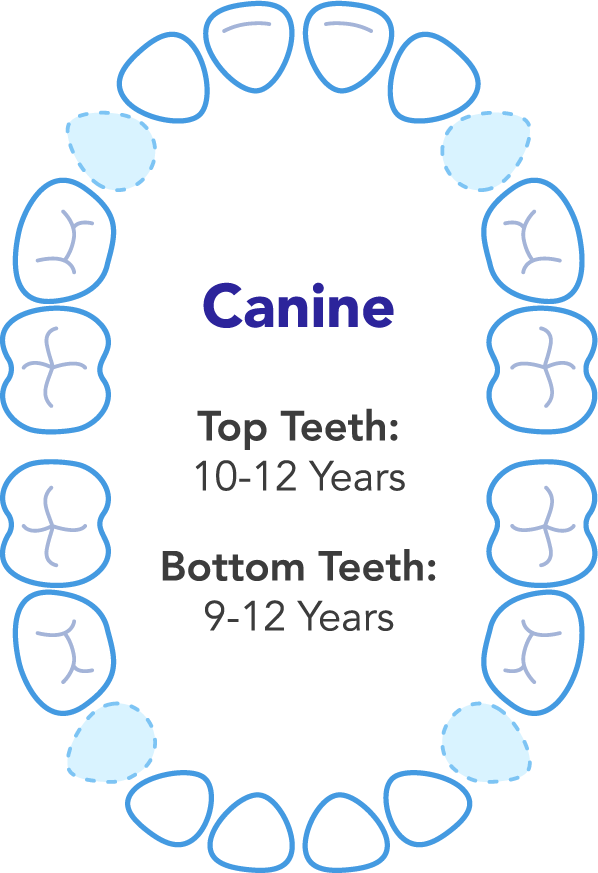
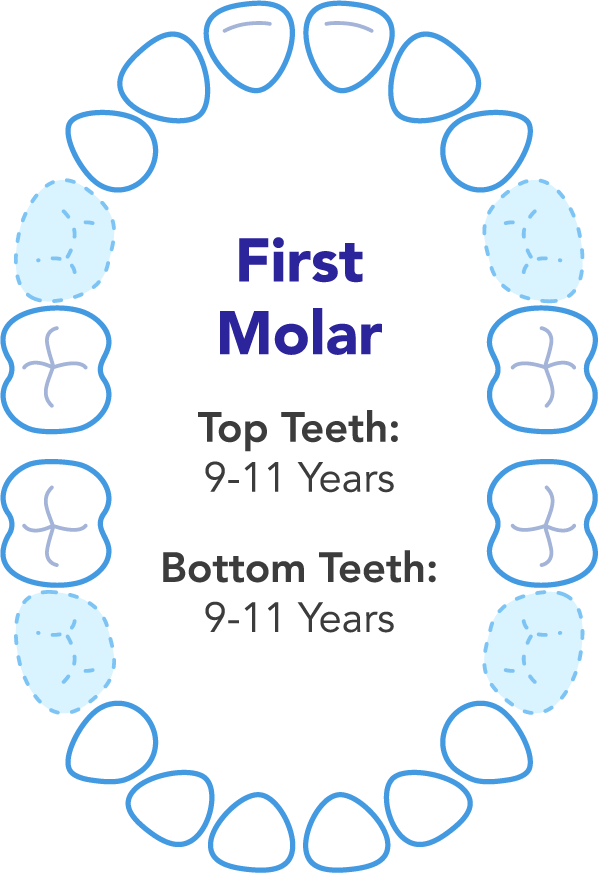
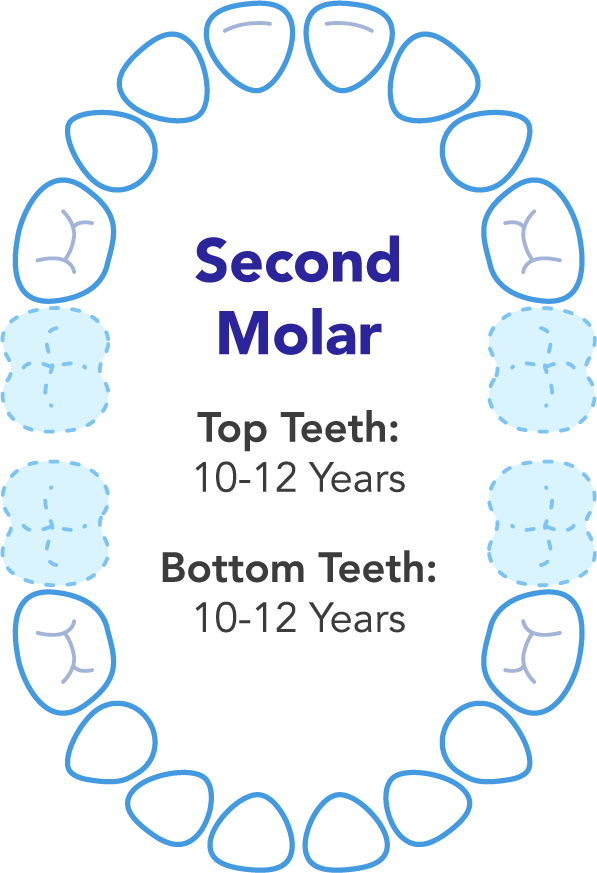
Click the arrows in the diagram to see an estimated progression of losing baby teeth.
Even though your child is brushing on their own, here’s how you can help.
Even if your child is brushing on their own, still check those chompers. Make sure they are brushing well and spitting out toothpaste.
While your child is now old enough for fluoride toothpaste, some dentists suggest a fluoride rinse, too. Ask your dentist at the next appointment.
Be generous with the verbal affirmation to inspire oral care. If your child is reluctant to brush, try talking about WHY brushing is important: it helps us look and feel better—and stay healthy!
Flossing can be tricky and the youngest lack the dexterity to twist and twirl a length of floss. Lend a helping hand but let them practice, too. Read on for flossing help.
Until your child can manage solo, you need to be the floss boss. Glide floss gently in between each tooth. And when you go to the next tooth, make sure you have a clean bit of floss.
Your tot might be a little fussy and antsy when you’re starting out. That’s totally normal. If you can’t floss all the teeth, don’t fret. Just give it time.
Work back to front, starting with the molars—if they have any. You can even let your little one give it a go. They probably won’t get it right away—it’s hard work for those little fingers! But they will be getting a feel for starting a healthy habit.
Even as children get older, they might need help with flossing. Don’t be alarmed if your child is still trying to get the hang of it at age 10. Flossing is a marathon habit; not a sprint.
The little plastic flossers tend to make flossing easier and more enjoyable. And any habit that is easier is more likely to be maintained. Give it a try if flossing thread is a challenge.
Kids might not see the point of flossing, but a simple conversation can help. Explain that getting all the gunk out helps to prevent cavities and even painful dental procedures down the road.
If your child is anxious or avoids brushing and flossing, encourage your child’s oral care routine with some clever and loving motivation.
One of the easiest ways for children to learn is by mimicking what they see. So, as you’re teaching your child how to brush and floss, model the behavior yourself. Have a great attitude about your oral health to show there’s no need to feel afraid.
Everything is more fun with a friend—even brushing! Invite your child to bring along a stuffed animal to brush, too. This lends a playtime feel to oral care and helps put your child at ease.
Compliments and positive reinforcements go a long way. A simple "you’ve got this," "nice job," or high five can affirm your child is on the right track. This handy My Happy Smiles calendar lets you and your kiddos set goals and track & reward every toothbrushing success.
Since your tyke might not see other kids brushing, they feel like the only one learning this new skill. But if you read books, watch videos, or even talk about brushing, it normalizes the task and makes it fun!
Once your child’s adult teeth start to come in, consider a visit to the orthodontist. Even if they don't have all of their adult teeth, an orthodontist can look at uneven bites and overcrowding of teeth. Most orthodontists say an ideal age is 7 for the first visit. Going to an ortho doesn’t always mean braces. Here’s what to expect...
For the first visit, the doctor will examine your child’s teeth, mouth, and jaw. They’ll ask questions about your child’s jaw—does it click or pop? Expect questions about chewing and swallowing issues as well.
Your ortho may take X-rays of your child’s mouth to see how teeth are coming in, if they are positioned correctly, and to check out any teeth that have yet to break the surface.
The doctor might make a mold of your child’s teeth. A mouth guard-shaped tray holds a gooey substance that is pressed into the teeth. After removal, the material hardens to make an impression. The ortho then examines the mold to determine the best treatment.
Between 3-6 years old, your child is visiting a dentist every 6 months and learning oral care habits. After age 6, it’s about protecting those permanent teeth with healthy dental habits.
Here are 4 things to watch.
Keep an eye out for white spots or brown areas on your child’s teeth. Those are signs of cavities and should be checked by a dentist.
If your child is into sports, ask your dentist about a protective mouth guard.
Brushing and flossing with braces is a pain in the brackets! Try a battery-powered toothbrush, such as Spinbrush™, or a water flosser, like Waterpik™, to avoid white spots on teeth when the braces come off.
When your child is rocking braces, there are SO MANY nooks and crannies to hide food particles. It’s super important to brush and rinse after meals and floss daily. Avoid foods that can damage braces like popcorn, hard or chewy candy, and gum.